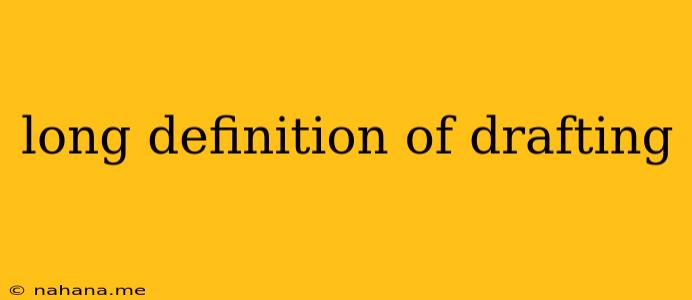Drafting is a multifaceted process that encompasses various stages and techniques, ultimately culminating in the creation of a final product, whether it be a written document, a visual design, or a physical object. It is a fundamental practice across numerous disciplines, serving as the foundation for communication, innovation, and realization. This comprehensive definition delves into the intricate aspects of drafting, exploring its significance, methods, and applications.
Defining the Drafting Process
At its core, drafting involves the initial development of a rough version of a final product, serving as a blueprint or framework for subsequent refinement. This initial stage is characterized by exploration, experimentation, and the articulation of core concepts. It is often iterative, with drafts being revised and reworked to achieve desired clarity, cohesiveness, and effectiveness.
Phases of Drafting
The drafting process can be broadly divided into several distinct phases:
1. Conceptualization
This phase involves the generation of ideas and the development of a clear understanding of the purpose and scope of the final product. It encompasses brainstorming, research, and the formulation of preliminary concepts.
2. Sketching and Outlining
Once a conceptual framework is established, the next step involves translating those ideas into a tangible form. This phase entails creating rough sketches, outlines, or drafts that capture the essence of the final product. These sketches are often informal and serve as a visual representation of the overall structure and flow.
3. Detailing and Refinement
Following the initial sketching phase, the draft undergoes further development and refinement, incorporating detailed information and addressing potential issues. This phase may involve expanding upon existing concepts, adding specific elements, and improving clarity and coherence.
4. Review and Feedback
The drafting process is not a solitary endeavor. Seeking feedback from others is essential to ensure that the draft is effective and meets the intended objectives. This phase involves sharing the draft with stakeholders and incorporating constructive criticism.
5. Finalization
The final phase involves polishing the draft and preparing it for final production or publication. This may include editing, proofreading, and making any necessary adjustments to ensure that the final product is well-written, visually appealing, and adheres to all relevant standards.
Applications of Drafting
Drafting is employed across a wide range of disciplines, including:
1. Writing
Drafting is an indispensable part of the writing process, from creating outlines for essays and articles to drafting speeches and novels.
2. Design
Drafting plays a crucial role in visual design, encompassing fields such as graphic design, product design, and architecture.
3. Engineering
In engineering, drafting is used to create blueprints and technical drawings, which are essential for constructing buildings, machines, and other complex structures.
4. Legal and Business
Drafting is also fundamental in the legal and business realms, where documents such as contracts, agreements, and legal briefs are meticulously drafted.
Significance of Drafting
Drafting is a crucial process for several reasons:
- Clarity and Communication: It ensures that ideas are clearly articulated and communicated effectively.
- Iteration and Improvement: It allows for the iterative refinement of concepts, leading to a more polished and effective final product.
- Organization and Structure: It provides a framework for organizing ideas and ensuring a logical flow.
- Innovation and Creativity: It fosters experimentation and encourages creative exploration.
- Efficiency and Collaboration: It streamlines the development process and facilitates collaboration between individuals.
In conclusion, drafting is a fundamental practice that is essential for effective communication, innovation, and the realization of complex projects. It is a multifaceted process that involves various stages, techniques, and applications, ultimately leading to the creation of high-quality and impactful final products. By embracing the principles of drafting, individuals and organizations can elevate their communication, enhance their creativity, and achieve greater success in their endeavors.
